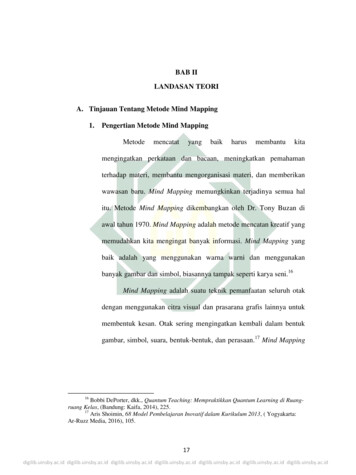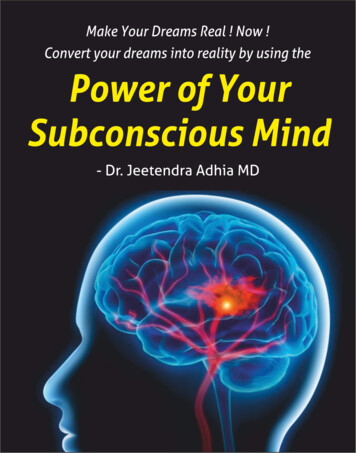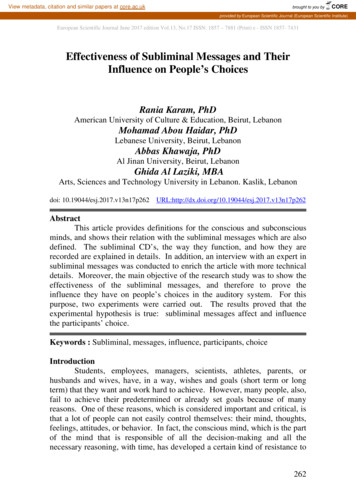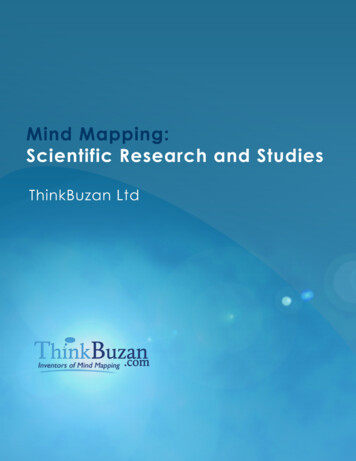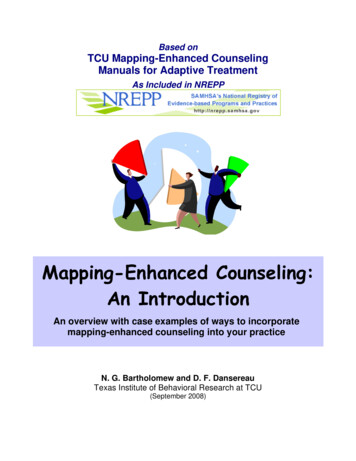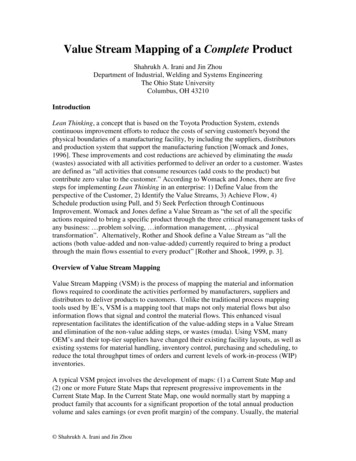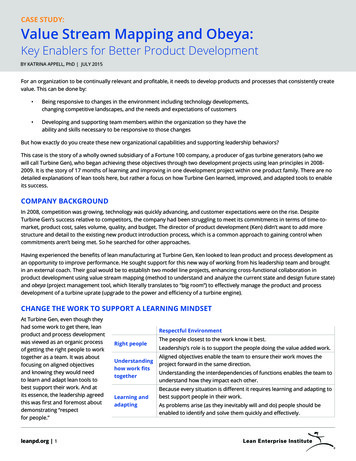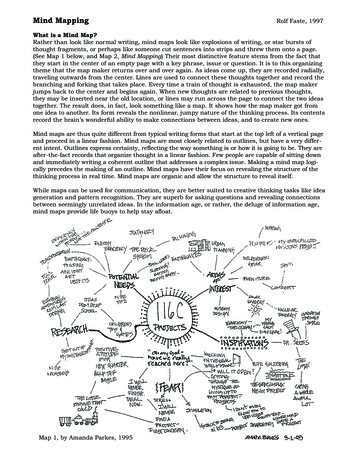
Transcription
Mind MappingRolf Faste, 1997What is a Mind Map?Rather than look like normal writing, mind maps look like explosions of writing, or star bursts ofthought fragments, or perhaps like someone cut sentences into strips and threw them onto a page.(See Map 1 below, and Map 2, Mind Mapping) Their most distinctive feature stems from the fact thatthey start in the center of an empty page with a key phrase, issue or question. It is to this organizingtheme that the map maker returns over and over again. As ideas come up, they are recorded radially,traveling outwards from the center. Lines are used to connect these thoughts together and record thebranching and forking that takes place. Every time a train of thought is exhausted, the map makerjumps back to the center and begins again. When new thoughts are related to previous thoughts,they may be inserted near the old location, or lines may run across the page to connect the two ideastogether. The result does, in fact, look something like a map. It shows how the map maker got fromone idea to another. Its form reveals the nonlinear, jumpy nature of the thinking process. Its contentsrecord the brain’s wonderful ability to make connections between ideas, and to create new ones.Mind maps are thus quite different from typical writing forms that start at the top left of a vertical pageand proceed in a linear fashion. Mind maps are most closely related to outlines, but have a very different intent. Outlines express certainty, reflecting the way something is or how it is going to be. They areafter-the-fact records that organize thought in a linear fashion. Few people are capable of sitting downand immediately writing a coherent outline that addresses a complex issue. Making a mind map logically precedes the making of an outline. Mind maps have their focus on revealing the structure of thethinking process in real time. Mind maps are organic and allow the structure to reveal itself.While maps can be used for communication, they are better suited to creative thinking tasks like ideageneration and pattern recognition. They are superb for asking questions and revealing connectionsbetween seemingly unrelated ideas. In the information age, or rather, the deluge of information age,mind maps provide life buoys to help stay afloat.Map 1, by Amanda Parkes, 1995
Why Mind Map?There are many reasons to use mind maps. (See Map 3, Why Mind Map?) When addressing an issuethey may be used: to reveal your thinking to yourself and perhaps to others; to flesh out the components of the subject; to figure out what is going on; to remember what you know about something,and to explore what you don’t know; to contextualize a situation, problem or need; to explore what isleft out, taken for granted, assumed, overlooked, or intentionally obscured; to find patterns, recurring themes, surprising connections; to explore where action is needed, or a new design might makea contribution; to reveal conventional wisdom, then to question it; to use as a tool that can be tentative, exploratory, and not draw definitive conclusions; to hang out with ideas; to organize thoughtsprior to presenting them in a linear format such as an essay or a speech.In The Mind Map Book, Tony Buzan has championed mind maps for studying, remembering andlearning. Many of his examples show notes taken from a lecture, or maps made from memory inpreparation for an exam. He makes a wonderful observation when he says, “Neat notes are messy,conceptually. Messy notes (mind maps) are neat conceptually.” By this he means that most studentstry to take notes going from the top of the page to the bottom. While they may be very neat, they don’tconvey the structure of the lecture. Even students who try to take notes in an outline form rarelysucceed in capturing the overall concepts that are being conveyed. On the other hand, notes takenfrom a mind mapping mode may look incredibly messy, but the overall structure of the lecture caneasily be discerned. After class, mind maps can be used to reconstruct the entire lecture.Others have championed mind maps as a means to organize thoughts prior to writing essays orcreative fiction. In English classes I have heard this activity referred to as cluster diagramming, orwebbing.At Stanford, we use maps to help teach design. My students use mind maps to explore need areas tobetter understand projects they are working on. We also ask them to mind map reading assignments.The intent here is not to record or duplicate the content of the author’s message, but rather to revealtheir thinking about the material, to ask questions and stimulate making connections to their ownideas and memories. When they have done this, they are well prepared to actively participate in classdiscussions.Mind maps can be private or public. Maps can record personal thinking done with no intention of being shared. They can be made in private, but knowing that they will be shared with others. They canbe made in private, then reorganized and redrawn for others. Or maps can be the result of a teamworking on a problem together.To summarize, mind maps can be used when persons want to do any of the following activities:To learnTo record a talk or lectureTo prepare for a talk or paperTo study for an examTo ask questionsTo exercise the brainTo communicateTo reveal the nature of your thinking to othersTo demonstrate a structure or pattern to othersTo organize your thoughts for a talkTo record a meetingTo generate enthusiasm and involvementTo generate creative ideasTo get started quicklyTo brainstorm alone, or with othersTo search for patterns and connectionsTo search for what is missingTo speculate: to ask, “what if?”To reveal and explore personal valuesTo dream and create a personal visionTo merge poetry and designTo “walk on a moonbeam” (Einstein)To make decisionsTo get everyone’s inputTo analyze a problemTo get organized, or organize informationTo separate the important from the extraneousTo be sure you are working on the right problemTo reach a consensus or a visionTo record everyone’s ideas in one place
Getting StartedMediaWhile maps can be done on letter sized plain white copy paper, the process is enhanced by havingmore space to work on. Treat yourself to large sheets of quality paper. 11”x17” or A3 is a nice sizebecause it can be easily photocopied and, folded in half (or Z folded), it can fit in normal notebooks.Beyond this, the only the limit is the size of your biggest table, or wall. People tend to look at mapsover and over again. Maps are often hung up for reference or review by others. It is a good idea to usehigh quality paper that will hold up to repeated use.My philosophy regarding materials is always to use the best possible. To some extent this is at oddswith the non precious mind-set that a mind mapper needs to adopt while exploring an idea. Biggersheets of paper have more white space, which can be intimidating. If this is a concern for you, start withsmall sheets of paper. It is always OK to add on paper any time an idea is about to run out of room.I advocate the use of ink pens rather than pencils. Pencils encourage erasing, which is both unrequired and a waste of time. Since “being correct” isn’t an objective of creative mind maps, there isno need to erase. Quite the reverse, it is really useful to record the entire thinking process includingdead ends and intuitive leaps. Maps and drawings done with pens also are more legible and photocopyable than those done with pencils. Black pens work best. A later section will explore the possibilities that arise when color is utilized.SpaceMind mapping doesn’t require a special space. It should simply be pleasant to be in and well lit. Ordinary chairs and solid tables are fine. The table should support working at the desired scale.If several people are going to work on the map, there must be room for everyone to reach the mapcomfortably. They don’t have to be able to reach the map from one side—they can be distributedaround it. Maps don’t have to have one side up. They can have no sense of gravity whatsoever. Thismay make them hard to read, but it allows people to come at the issue from all directions. The mapcan be redrawn with a single orientation later.TimeYou need as much time as is appropriate for the task. A one minute map can greatly improve a 15minute essay. A thoughtful one hour map will make a useful contribution to any project. An all daymap making session may be appropriate for a research group trying to summarize the status of aproject, or deciding where to allocate resources.It is best if you can get all your main thoughts onto a map in one work session. It is hard to comeback to a half finished map and pick up both the nature and spirit of a train of thought. Your firstattempt at a map doesn’t have to be perfect. One of the nice features of maps is that you can alwayscome back and add more ideas. As we will see, maps require a certain level of richness in order tobecome useful. This takes time. Start a map only when you will have enough time to finish it.Basic PrinciplesThe basic principles of mind mapping are: (see Map 4, The How of Mind Mapping)1234567891011Create a Center Statement.Develop ideas radially outward.Capture ideas quickly.Use lines to show connections.Create train-of-thought structures.Follow an idea as far as it will go.Work from the known to the unknown.Return to the center when ideas are exhausted.Increase density to create richness.Avoid being judgmental.Have fun with the form.
1. Create a Center Statement. The title in the center should state the topic, issue or question thatis being addressed. The key thing about the center statement is that you will be continually returning to it. Not only will you be returning to it, but you will be returning to it when you have run out ofthings to say during your previous stream of thought. So this center statement should be somethingthat you really want to come back to. If you simply want to explore a topic, write it down. In the attached example, “Mind Mapping,” written big and bold, indicates clearly what the map is going to beabout. When your issue is an aspect of a bigger topic, write the aspect. These titles may be simpleand straight forward, or snappy according to your preference. If you address issues that excite you,fascinate you, or that you can generate some emotion about, making a map will be fun. The bestmaps are maps you want to make. The title should foster this enthusiasm.The center statement may also be a whole sentence. Problems are often best written this way. I’ll saymore about this later. Likewise, If you are addressing a specific question, write the question. Questions or complete sentences tend to tighten up the exploration and give a map more focus.The beauty of writing the issue in the center of the page is that you are no longer facing a blanksheet of paper. When you start at the top, you are still facing an empty page. Worse, the empty pageis really demanding that the most logical next idea be written next. When you start in the center, thepaper is already messed up. Furthermore, it doesn’t matter where you go next. This makes it mucheasier to get going. The ice is truly broken.2. Develop ideas radially outward. The next step is to look at this statement, think of the first thingyou want to say, draw a line away from the statement and say it. When I start, sometimes I look atthe center and realize that there are several categories that will need to be addressed. In our ownexample, these were the obvious ones: how, where, when, and why do we mind map? I could drawseveral lines out in different directions, and write these words down. I find this often leads to organization problems because I can’t predict how much room each issue will require. So I often put themdown in a clump, or take notes on scratch paper so I won’t forget them. That way, when I address thenext issue I can put the key word in a location that provides enough room to explore it.3. Capture ideas quickly. Complete sentences aren’t required. Key-words, phrases and even quicksketches, drawings, diagrams and symbols are fine. Ideas often come faster than you can write themdown. The trick is to record them well enough to remember what you were thinking. When you aredone you can go back in with a fine pen and clarify your thoughts or add detail. Usually I find thatwhen I am past this first level and into a sub-issue like “Why Mind map?” I am off and running.The urge to be even more organized and think of still finer categories is no longer with me. I’m sureeveryone differs on this. After I brainstorm many topics I realize, “Oh, note-taking and studying foran exam are related, they both have to do with learning.” So I could have had a subcategory namedlearning. This is the beginning of the pattern recognition stage.4. Use lines to show connections. As ideas come, they flow outward. As you think of related ideas,draw a line from the previous idea and write it down. The lines indicate the connections. Whetherthey are obvious or not, our minds work in metaphorical leaps. It is often interesting and valuable tosee where ideas came from. You can use different kinds of lines: fat ones, thin ones. One of my students, Peter MacDonald, hit upon using double lines to show emphasis. His maps looked like superhighways with interchanges and arterial feeders. Lines can connect clumps of words, or they canbranch off the other lines. There are no correct rules. You can make your own. Wavy lines can indicate uncertainty. Dotted lines metaphorical leaps. A long line can run across a distance, leaping other lines in the way, to connect distant ideas together, or simply to find room to add more thoughts.5. Create train of thought structures. This continual connecting and branching reveals a structureof thought. The solid collection of lines clearly indicate how the ideas flowed from one to another.
Map 2, Mind Mapping, Rolf Faste, 1993
Map 3, Why Mind Map? by Rolf Faste, 1993
Map 4, The How of Mind Mapping, Rolf Faste, 1993
Map 5, What do People Carry? by Joy Sih
Map 6, Needfinding maps by Alex Walsh.These maps show the increasing density of ideas that come with practice.
Map 7, Basic Needs by Joy Sih and Angie Hockman
Map 8, Threatby Hal Monson.This map exploresthe nature ofthreat for hisMaster’s Thesis
Map 9, The Mind’s Eye, lecture notes by Rolf Faste from a talk by Sara Little Turnbull, 1995
Map 10, Pattern Recognition, Rolf Faste, 1993
6. Follow an idea as far as it will go. Sooner or later, ideas come to an end. At some point I tend torun out of gas, or I have really said enough about that issue, or have gone thoroughly off the track,or gotten to the point where I have nothing but questions. That’s the time to stop the train.7. Work from the known to the unknown. Questions are a good place to wind up. Because we tendto work from the known to the unknown, it is normal to have questions at the fringe of the map.Knowledge becomes less certain and rather fuzzy at the edges, just like a 17th century world map.Questions are a great way to summarize an idea chunk and provide a good place to stop.8. Return to the center when ideas are exhausted. When you have finished a thought, go back tothe center. If you have already have another category in mind, you can begin on that. If not, look atthe center idea until you think of another issue to explore. In my example, I came back to “Where tomind map?,” and I was off and running again. Repeat the cycle of coming to the center and startingover until you have exhausted your thoughts on the subject or just plain run out of room. Note that ifyou really need more space you can tape on an extension.9. Increase density to create richness. Interesting and insightful maps occur when a certain density of ideas is achieved. Density creates a critical mass—the opportunity for fission and fusion of ideasand concepts. When there are a lot of ideas, they jostle each other and bounce off each other—theybreak apart and re-combine in unexpected and delightful patterns.Map 6 shows four maps done by a student during weeks 2, 3, 4 and 6 while taking a class whichexplores human need. Each one concerns a possible design project. The first explores an issue raisedwhile spending time with Paramedics, i.e., Inability to Breathe. The others continue with Windsurfing, First Aid, and Self Defense. These maps show a clear and intentional progression from simpleand elementary to dense and rich. The first map might be appropriate for communicating an idea tosomeone else, but is not rich enough to generate new insights about the issue of breathing. In remarkable contrast, the last map is far more likely to reveal a multiplicity of fruitful approaches to hisproblem. It is also far more interesting for a reader to study—the density of ideas creates an involvement with the thinking process itself.A wonderful feature of mind maps is that you can go back into a map and use the interstitial spacesto record new ideas and insights. Often increasing the density can turn a ho-hum map into an exciting one (see Map 7). Achieving such density takes time, which is why it is important to commit a sufficient amount of time to the effort.10. Avoid being judgmental. In any creative process, premature criticism kills ideas before theyeven have a chance to breathe. Problem solving sessions should not tolerate critical comments whileideas are flowing. This applies to mind mapping just as it applies to brainstorming. It should be anexpressive, exploratory activity. Mind maps are best when free flowing, speculative and uncensoredby our judgmental self.At Stanford we characterize the creative process with the acronym “ETC.” Professor Bob McKimcoined this phrase which stands for Express, Test, Cycle. The key idea is to separate creative thinking (Expressing Ideas) from judgmental thinking (Testing Ideas). There should be no censorship,testing or judging allowed while in the expressive, idea generating phase of thinking. Once we have alarge number of ideas (or solution candidates), we can stand back, be objective, and make judgmentsabout our ideas. If we have possible solutions to our problems, great. If not, we Cycle again and beginanother Express phase.11. Have fun with the form. Mind maps often exhibit the map maker’s sense of aesthetics and playfulness (see Map 8). People who make a lot of maps often become very creative in finding new formsthat help them communicate their ideas, or simply make them more fun to do. We will discuss someof these forms later as they can be quite useful.And now it’s time to make some maps!
In The Mind Map Book, Tony Buzan has championed mind maps for studying, remembering and learning. Many of his examples show notes taken from a lecture, or maps made from memory in preparation for an exam. He makes a wonderful observation when he says, “Neat notes are messy, conceptually. Messy n
